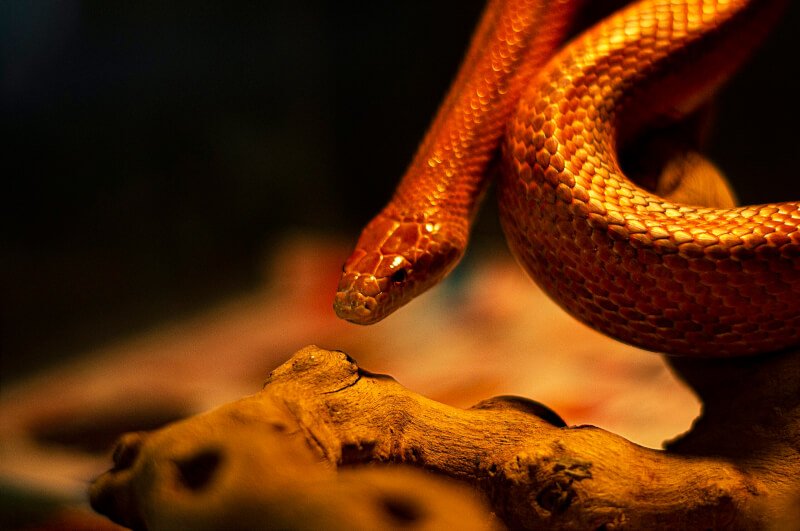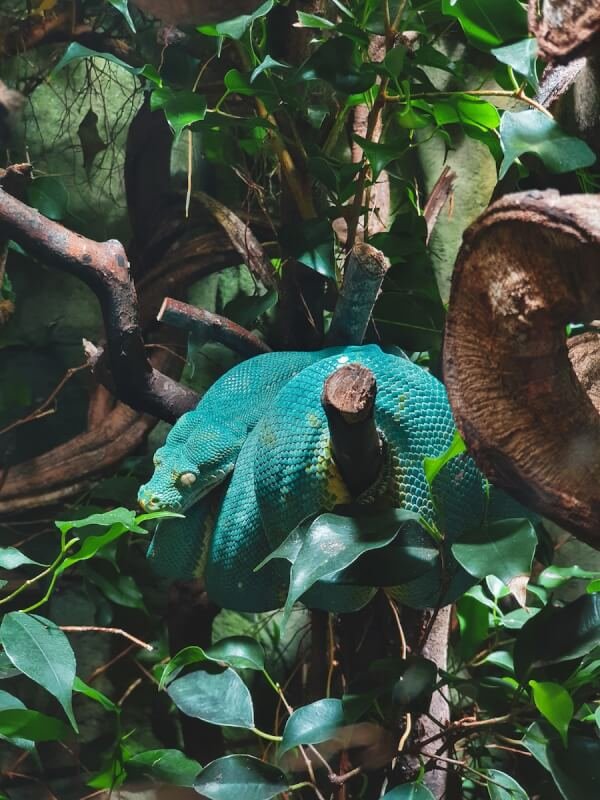Snakes are fascinating creatures that can be found in a variety of environments around the world. From dense rainforests to dry deserts, these slithery reptiles have managed to adapt and thrive in diverse habitats. But have you ever wondered where exactly snakes call home in the wild? In this article, we will unravel the secrets of snake habitats, exploring the different regions and climates where these elusive creatures make their homes. So, get ready to uncover the hidden dwellings of snakes and gain a deeper understanding of their wild habitats.

Habitat Requirements For Snakes
Snakes are fascinating creatures that can be found in various habitats around the world. Understanding their habitat requirements is crucial for their survival and conservation. Snakes have specific climate, vegetation, water source, and terrain preferences that vary depending on their species and evolutionary adaptations. Let’s explore the different types of habitats where snakes can be found and the specific conditions they thrive in.
Climate
Climate plays a significant role in determining the distribution of snakes. Different snake species have evolved to survive in specific climatic conditions. Some species prefer hot, arid climates found in deserts, while others thrive in cooler, temperate environments. It is essential to note that snakes are ectothermic, meaning they rely on external heat sources to regulate their body temperature. Therefore, they need areas where they can bask in the sun or seek shelter to avoid extreme temperatures.
Vegetation
The types of vegetation present in an area greatly influence the snake species that inhabit it. Grasslands, forests, mountains, and farmlands each provide unique vegetation characteristics that attract different snake species. For example, grasslands are home to snakes that prefer open spaces and rely on grasses for cover and hunting opportunities. In contrast, forested areas contain snakes that thrive in the dense undergrowth and use trees for shelter and hunting vantage points.
Water Sources
Snakes, like all living organisms, require access to water for survival. While some snake species are adapted to arid environments with limited water sources, others live near rivers, lakes, wetlands, and swamps. Access to water is essential for drinking and maintaining hydration, as well as attracting potential prey. Snakes that inhabit aquatic ecosystems have evolved unique adaptations to swim, hunt, and survive in watery environments.
Terrestrial Snakes
Terrestrial snakes refer to those that predominantly live on land, rather than in aquatic or arboreal environments. They can be found in a variety of habitats based on their specific adaptations and preferences. Let’s explore some common habitats where terrestrial snakes can be found.
Grasslands
Grasslands provide an ideal habitat for many snake species. The vast open spaces and abundant vegetation create a suitable hunting ground. Snakes that reside in grasslands rely on the grasses for cover and use their camouflaged bodies to blend in with the surroundings. The presence of small mammals, such as rodents, in grassland ecosystems serves as a plentiful food source for these snakes.
Deserts
Deserts pose unique challenges for snakes due to their extreme temperatures and arid conditions. However, many snake species have successfully adapted to life in the desert. These snakes possess specialized mechanisms that allow them to conserve water and tolerate high temperatures. They often burrow into the sand during the day to avoid the scorching heat and emerge at night to hunt for prey.
Forests
Forests are incredibly diverse habitats that support a wide range of snake species. Snakes within forested areas adapt to the dense vegetation and utilize trees, fallen logs, and leaf litter for shelter and camouflage. These habitats often provide an abundance of small mammals, birds, and reptiles, serving as a food source for forest-dwelling snakes. Different types of forests, such as tropical rainforests and deciduous forests, offer specific conditions that attract different snake species.
Mountains
Mountainous regions present their own set of challenges for snake survival. As altitude increases, the climate becomes cooler and the habitats change. However, snakes can still be found in mountainous areas. They tend to inhabit lower elevations where the conditions are milder and the prey availability is higher. Rocky slopes and crevices provide ideal hiding spots and sun-exposed areas for basking.
Farmlands
Snakes can also be found in human-altered habitats such as farmlands. These areas often provide a readily available food source in the form of rodents that are attracted to the crops. Snakes can act as natural pest control agents, helping to maintain a balance between agricultural productivity and the ecosystem. However, caution must be exercised to ensure the safety and coexistence of snakes and humans.
Aquatic Snakes
Aquatic snakes are highly adapted to life in water and are commonly found in a variety of freshwater and coastal habitats. Let’s explore the different types of aquatic habitats that these snakes call home.
Freshwater Habitats
Freshwater habitats, including rivers, streams, and ponds, are vital ecosystems that support a rich diversity of aquatic life, including snakes. These habitats provide a consistent source of water, abundant food, and varied shelter options. Aquatic snakes have evolved streamlined bodies and partially webbed tails, enabling them to move efficiently in water.
Rivers and Streams
Rivers and streams are dynamic habitats that are home to a wide range of aquatic snake species. Snakes in these environments are adept swimmers, and they use the flowing water and riverbanks for various activities, including hunting, mating, and seeking shelter. They often rely on riverbed crevices, fallen logs, and overhanging vegetation for protection and basking opportunities.
Ponds and Lakes
Ponds and lakes are stagnant water bodies that provide a different set of challenges and opportunities for aquatic snakes. Snakes in these habitats may encounter a more sedentary lifestyle, as they navigate through still waters and rely on the vegetation and water edges for cover. These habitats often support a diverse array of prey, such as fish, amphibians, and invertebrates, making them excellent hunting grounds for aquatic snakes.
Wetlands and Swamps
Wetlands and swamps are unique ecosystems characterized by a high water table and the presence of water-loving plants. Snakes that inhabit these areas have adapted to the dense vegetation and murky waters. They utilize the vegetation as cover and ambush points, patiently waiting for their prey to pass by. Wetlands and swamps support a vast range of prey species, making them highly productive habitats for aquatic snakes.
Coastal Areas
Coastal areas, including estuaries, sandy beaches, and mangrove forests, provide coastal-dwelling snake species with a wealth of resources. Snakes found in these habitats are well-adapted to the brackish or saltwater conditions. Mangrove forests, in particular, offer a complex network of roots and aerial prop roots that snakes use for shelter and hunting. Coastal environments often provide access to both aquatic and terrestrial prey, making them highly productive habitats.
Burrowing Snakes
Burrowing snakes have evolved a specialized lifestyle that involves spending a significant amount of time underground. These snakes are excellent diggers and rely on specific soil types for their burrowing behaviors. Let’s explore the different types of soils that burrowing snakes prefer.
Sandy Soils
Snakes that prefer sandy soils are often found in arid or coastal environments. Sandy soils provide loose and easily excavatable substrate, allowing snakes to create burrows for shelter and reproduction. The loose texture of sandy soils helps prevent collapse and allows snakes to move freely within their burrows. These habitats often support a variety of prey, such as small lizards and insects, that these snakes rely on for sustenance.
Clay Soils
Clay soils present a different set of conditions for burrowing snakes. These soils are typically dense and have a higher water-holding capacity than sandy soils. Snakes that inhabit clay soils often create burrows along the banks of rivers, where the clay is more easily excavated. The stable structure of clay allows for more extensive and complex burrow systems. These snakes primarily feed on small rodents and amphibians found in the vicinity of their burrows.
Loamy Soils
Loamy soils are a combination of sand, silt, and clay, offering a balance of drainage and water retention capabilities. Some burrowing snake species thrive in these soils, as they provide stability for the burrows while still allowing some moisture regulation. Snakes in loamy soil habitats often exist in transitional zones between other soil types, taking advantage of the favorable attributes each soil component offers. The prey items consumed by snakes in loamy soil habitats can vary greatly, depending on the surrounding ecosystem.
Arboreal Snakes
Arboreal snakes, as the name suggests, are adapted to life in trees and other elevated habitats. These snakes have unique characteristics that allow them to navigate and thrive in various arboreal habitats around the world.
Tropical Rainforests
Tropical rainforests are biodiversity hotspots and are home to a rich assortment of snake species. Arboreal snakes found in these lush habitats have evolved to climb trees, utilizing specialized scales on their bellies and tails that provide grip. They often rely on camouflage, mimicking tree branches and blending seamlessly into their surroundings. Prey items such as birds, small mammals, and lizards are abundant in tropical rainforest ecosystems, providing a diverse food source for arboreal snakes.
Mangrove Forests
Mangrove forests are unique coastal habitats characterized by dense, tangled roots that extend above the water surface. These intricate root structures offer a perfect environment for arboreal snakes. Mangrove-dwelling snakes can move swiftly through the branches, while the tangled roots provide protective shelter. The mangrove ecosystem also supports a variety of prey items, including fish, crabs, and amphibians, ensuring a steady food supply for arboreal snakes.
Deciduous Forests
Deciduous forests, with their changing seasons and diverse plant life, also support a range of arboreal snake species. Snakes in deciduous forests have adapted to the changing foliage, utilizing trees for thermoregulation and hunting. They often undergo hibernation during the colder months, seeking shelter in tree cavities or leaf litter. Prey availability in deciduous forests can vary throughout the year, with snakes consuming a variety of small mammals, birds, and reptiles.
Snakes in Human Habitats
Snakes possess remarkable adaptability and can be found in various human-altered habitats. Let’s explore how they navigate and coexist in urban, suburban, and rural areas.
Urban Areas
Urban areas, with their concrete jungles, may not seem like ideal snake habitats at first glance. However, snakes have demonstrated their ability to adapt to these environments. Urban areas often provide an abundance of prey in the form of rodents and insects, attracting snake species that thrive on these food sources. Snakes in urban environments typically find shelter in gardens, parks, and vacant lots, making use of available vegetation or man-made structures.
Suburban Areas
Suburban areas offer a blend of natural and human-altered landscapes, providing potential habitats for snakes. Residential gardens, parks, and green spaces serve as attractive locations for snakes seeking food and shelter. Suburban areas may also have nearby natural habitats, such as forests or grasslands, where snakes can retreat to during certain seasons or for specific activities like mating.
Rural Areas
Rural areas, characterized by agricultural lands and less dense human population, often provide ample opportunities for snakes. Farms, fields, and meadows support a high density of small mammals and reptiles, making them prime hunting grounds for snakes. Snakes in rural areas contribute to pest control by preying on rodents and other crop-damaging pests. The presence of natural habitats nearby further enhances the diversity of snake species in rural areas.

Underground Snakes
Underground habitats provide a unique environment for certain snake species. These snakes have adapted to live primarily underground and rely on specific underground structures for shelter and hunting.
Caves
Caves offer dark and cool environments that are ideal for snakes seeking shelter and hibernation sites. Snakes that inhabit caves are often non-venomous and have specialized adaptations, such as heat-sensing abilities, to aid in hunting prey in low-light conditions. Caves also provide a stable microclimate that helps regulate temperature and humidity, crucial for snake survival.
Rock Crevices
Rock crevices and rock piles provide excellent hiding spots and den sites for underground-dwelling snakes. These snakes often utilize the gaps in rocks to create safe retreats and ambush points. The rocky terrain affords protection from predators and helps maintain a suitable microclimate within the crevices. Snakes in rock crevice habitats often feed on small rodents that inhabit the rocky outcrops.
Rodent Burrows
Snakes that live in rodent burrows have evolved to take advantage of the existing tunnels created by small mammals. These snakes are typically small and slender, allowing them to maneuver through the narrow tunnels. By co-opting rodent burrows, these snakes can conserve energy and avoid predation while waiting for prey to pass by. The abundance of rodents in and around these burrows ensures a consistent food supply.
Snakes in Different Regions
Snakes can be found on every continent except Antarctica. Different regions of the world offer unique habitats and ecosystems that support diverse snake species. Let’s explore some of the common regions where snakes thrive.
North America
North America boasts a rich diversity of snake species, ranging from the venomous rattlesnakes to harmless garter snakes. Snakes in North America inhabit a variety of habitats, including deserts, forests, wetlands, and grasslands. The continent’s vast land area and diverse climate zones provide ample opportunities for snakes to thrive and adapt to various ecological niches.
South America
South America is home to an incredible array of snake species, including the iconic anaconda and vividly colored coral snakes. The Amazon rainforest, one of the world’s most biodiverse regions, is a hub of snake diversity. South American snakes can also be found in a range of other habitats such as grasslands, mountainous regions, and coastal areas.
Africa
Africa is home to a multitude of snake species, many of which are highly adapted to the diverse ecosystems found on the continent. Snakes in Africa can be found in grasslands, savannas, tropical rainforests, deserts, and mountainous regions. The Nile crocodile, a saltwater crocodile species, also occurs in certain parts of Africa.
Asia
Asia boasts a wide variety of snake species, found across its diverse expanse of habitats. Jungles, mountains, deserts, and grasslands provide homes for these snakes. The Indian subcontinent, one of the most snake-rich areas in the world, harbors species such as cobras, vipers, and pythons. Snakes in Asia play important ecological roles, helping to maintain balanced ecosystems.
Australia
Australia is known for its unique and often venomous snake species. The continent’s distinct ecosystems, including deserts, rainforests, and coastal regions, provide diverse habitats for snakes. Australia is home to iconic snakes such as the inland taipan, coastal taipan, and western brown snake. Due to their potentially lethal venom, proper understanding and respect for Australian snakes is crucial for human safety.
Snakes in Different Ecosystems
Snakes are integral components of various ecosystems, where they help maintain ecological balance as both predators and prey. Let’s explore how snakes contribute to the functioning of different ecosystems.
Desert Ecosystems
Desert ecosystems are characterized by extreme heat, limited water resources, and sparse vegetation. Snakes in deserts play critical roles as predators, controlling rodents and insect populations. Some desert snake species also serve as prey for larger predators, contributing to energy transfer within the ecosystem. Desert snakes have unique adaptations that enable them to survive in harsh environments, including efficient water conservation methods and heat tolerance.
Forest Ecosystems
Forest ecosystems, whether tropical or temperate, rely on snakes as both predator and prey. Snakes control populations of small mammals, birds, and reptiles, helping to maintain ecological balance. At the same time, forests provide shelter, camouflage, and hunting opportunities for arboreal, terrestrial, and burrowing snake species. Snakes contribute to the decomposition process in forests by consuming carrion and helping to recycle nutrients.
Grassland Ecosystems
Grassland ecosystems are characterized by open spaces, expansive grasses, and a diverse array of herbivores. Snakes in grasslands play crucial roles in regulating rodent populations, which can otherwise cause extensive damage to crops and grasses. Their presence helps to maintain a healthy balance between predator and prey populations. Additionally, snakes serve as prey for various birds of prey, contributing to the intricate food web within grassland ecosystems.
Aquatic Ecosystems
Aquatic ecosystems, including freshwater rivers, ponds, and coastal areas, rely on aquatic snakes for their ecological functioning. These snakes help control populations of fish, amphibians, and invertebrates, playing a pivotal role in the balance of these ecosystems. By keeping prey populations in check, aquatic snakes help maintain healthy habitats for other aquatic organisms.
Snakes and Their Preferred Prey
Snakes have adapted to feed on a variety of prey items, depending on their size, habitat, and evolutionary adaptations. Let’s explore the broad range of prey that snakes consume.
Rodents
Rodents, such as mice and rats, are a common and abundant food source for many snake species. Snakes that inhabit grasslands, forests, farmlands, and urban areas often rely on rodents as their primary prey. The ability of snakes to control rodent populations is particularly valuable in agricultural settings, where rodents can cause significant damage to crops.
Amphibians
Amphibians, including frogs, toads, and salamanders, are also important prey items for snakes. Snakes that reside near wetlands, swamps, and ponds often feed on amphibians. Snakes have evolved various mechanisms to capture and consume amphibians, including specialized jaws and digestive systems that can handle the toxins often present in their prey’s skin.
Birds
Birds, both ground-dwelling and arboreal species, are occasionally targeted by certain snake species. Snakes that reside in forests, grasslands, and coastal ecosystems may capitalize on the presence of birds as a food source. Arboreal snakes, in particular, have adapted to climb trees and ambush nesting birds or capture them in flight.
Fish
Aquatic snakes, as the name suggests, often feed on fish. These snakes have evolved streamlined bodies and specialized jaws that allow them to capture and consume slippery fish underwater. Coastal habitats, rivers, streams, and ponds are common locations where fish-eating snakes can be found.
Invertebrates
Invertebrates, such as insects, spiders, and worms, are an essential part of the diet for many snake species. Snakes that inhabit underground or forest habitats may rely on invertebrates for sustenance. They often use their keen senses to detect vibrations or scents that lead them to their invertebrate prey.
In conclusion, snakes are incredibly adaptable creatures, capable of thriving in a wide range of habitats across the globe. Their habitat requirements encompass climate, vegetation, water sources, and terrain preferences. Understanding and respecting these requirements are crucial for the conservation and preservation of snake species. Whether in terrestrial, aquatic, arboreal, human-altered, or underground habitats, snakes play vital roles in maintaining ecological balance and enhancing biodiversity. By appreciating and valuing the diversity of snake habitats, we can contribute to the conservation efforts necessary to protect these fascinating creatures for future generations.


